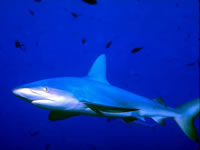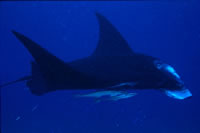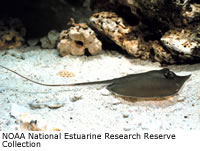Sharks
 There are over 300 species of sharks. Sharks have long torpedo-shaped bodies and skeletons made of cartilage, not bone. Cartilage is very flexible. You have cartilage in your ears and nose. The shark's skin is covered with teeth-like scales called dermal denticles. Dermal denticles cut down on drag when the shark is swimming. They also protect the shark from injury. Bony fish have gas-filled swim bladders that keep them afloat. There are over 300 species of sharks. Sharks have long torpedo-shaped bodies and skeletons made of cartilage, not bone. Cartilage is very flexible. You have cartilage in your ears and nose. The shark's skin is covered with teeth-like scales called dermal denticles. Dermal denticles cut down on drag when the shark is swimming. They also protect the shark from injury. Bony fish have gas-filled swim bladders that keep them afloat.
 Sharks don't have swim bladders. They stay afloat, in part, because their pectoral or side fins work like the wings of a plane, only under water! Because they don't have swim bladders, sharks must constantly swim. If they stop swimming, they sink! Sharks have sharp, triangle-shaped teeth. Their teeth grow in rows. The shark's jaw is loosely connected to its skull, which lets it open its mouth really wide! Most sharks are meat-eaters, but the basking shark and the whale shark eat plankton! Sharks don't have swim bladders. They stay afloat, in part, because their pectoral or side fins work like the wings of a plane, only under water! Because they don't have swim bladders, sharks must constantly swim. If they stop swimming, they sink! Sharks have sharp, triangle-shaped teeth. Their teeth grow in rows. The shark's jaw is loosely connected to its skull, which lets it open its mouth really wide! Most sharks are meat-eaters, but the basking shark and the whale shark eat plankton!
|
| | |
Rays
 Rays are closely related to sharks. They have flat bodies with eyes and mouths on their undersides. They have long slender tails. Some rays skim the ocean floor looking for food. Many rays have strong jaws that help them crush mollusks and crustaceans. Like sharks, rays don't have a swim bladder, but unlike sharks, they move their pectoral fins when they swim. They also must stay in motion constantly or they will sink!
 Electric rays make their own electricity! They have organs on either side of their heads that can deliver a shock of up to 200 volts! They use this electric shock to scare away predators and to shock prey. Stingrays, eagle rays and devil rays have spiny stingers on their tails that can inject a predator with venom.
unless otherwise noted
|